Items filtered by date: December 2024
Diabetic Neuropathy and the Feet
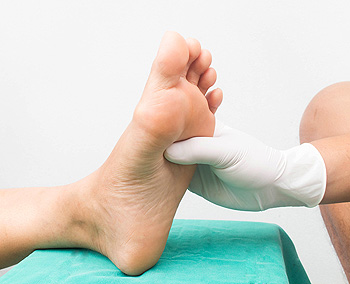
Diabetic neuropathy is a common complication of diabetes that can cause nerve damage in the feet, toes, and ankles. Elevated blood sugar levels over time can harm the peripheral nerves, leading to symptoms such as numbness, tingling, burning sensations, or sharp pain. Many people experience a gradual loss of sensation, which increases the risk of unnoticed injuries like blisters or cuts. Left untreated, these minor wounds can lead to serious infections, ulcers, and, in severe cases, gangrene or amputation. Reduced muscle strength and coordination from neuropathy may also affect balance and gait, increasing the risk of falls. To prevent complications from diabetic neuropathy, it is important to maintain proper foot care and routine foot inspections. A podiatrist can perform an exam to assess nerve function, detect early signs of problems, and provide treatment for wounds or other foot issues. This foot doctor can also offer advice on footwear to reduce pressure and prevent injury. If you are experiencing symptoms of diabetic neuropathy, it is suggested that you schedule an appointment with a podiatrist for an exam and ongoing treatment.
Neuropathy
Neuropathy can be a potentially serious condition, especially if it is left undiagnosed. If you have any concerns that you may be experiencing nerve loss in your feet, consult with Anas Khoury, DPM from North Eastern Foot & Ankle Specialists. Our doctor will assess your condition and provide you with quality foot and ankle treatment for neuropathy.
What Is Neuropathy?
Neuropathy is a condition that leads to damage to the nerves in the body. Peripheral neuropathy, or neuropathy that affects your peripheral nervous system, usually occurs in the feet. Neuropathy can be triggered by a number of different causes. Such causes include diabetes, infections, cancers, disorders, and toxic substances.
Symptoms of Neuropathy Include:
- Numbness
- Sensation loss
- Prickling and tingling sensations
- Throbbing, freezing, burning pains
- Muscle weakness
Those with diabetes are at serious risk due to being unable to feel an ulcer on their feet. Diabetics usually also suffer from poor blood circulation. This can lead to the wound not healing, infections occurring, and the limb may have to be amputated.
Treatment
To treat neuropathy in the foot, podiatrists will first diagnose the cause of the neuropathy. Figuring out the underlying cause of the neuropathy will allow the podiatrist to prescribe the best treatment, whether it be caused by diabetes, toxic substance exposure, infection, etc. If the nerve has not died, then it’s possible that sensation may be able to return to the foot.
Pain medication may be issued for pain. Electrical nerve stimulation can be used to stimulate nerves. If the neuropathy is caused from pressure on the nerves, then surgery may be necessary.
If you have any questions, please feel free to contact our office located in Passaic, NJ . We offer the newest diagnostic and treatment technologies for all your foot care needs.
Hammertoe Facts
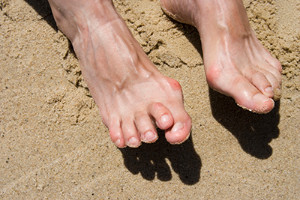
Hammertoe is a deformity where one or more toes bend abnormally at the middle joint, causing them to resemble a hammer. This condition can be caused by several factors, including wearing tight or ill-fitting shoes that force the toes into unnatural positions. Over time, the muscles and tendons in the toe become imbalanced, leading to the deformity. Other causes include injury, arthritis, and genetic predisposition. Symptoms of hammertoe include pain or discomfort in the affected toes, especially when wearing shoes or walking for long periods. The toes may become stiff and difficult to straighten, and in some cases, corns or calluses can form on the tops or tips of the toes due to pressure. If you have symptoms of hammertoe, it is suggested that you consult a podiatrist who can offer you effective relief and treatment solutions.
Hammertoes can be a painful condition to live with. For more information, contact Anas Khoury, DPM of North Eastern Foot & Ankle Specialists. Our doctor will answer any of your foot- and ankle-related questions.
Hammertoe
Hammertoe is a foot deformity that occurs due to an imbalance in the muscles, tendons, or ligaments that normally hold the toe straight. It can be caused by the type of shoes you wear, your foot structure, trauma, and certain disease processes.
Symptoms
- Painful and/or difficult toe movement
- Swelling
- Joint stiffness
- Calluses/Corns
- Physical deformity
Risk Factors
- Age – The risk of hammertoe increases with age
- Sex – Women are more likely to have hammertoe compared to men
- Toe Length – You are more likely to develop hammertoe if your second toe is longer than your big toe
- Certain Diseases – Arthritis and diabetes may make you more likely to develop hammertoe
Treatment
If you have hammertoe, you should change into a more comfortable shoe that provides enough room for your toes. Exercises such as picking up marbles may strengthen and stretch your toe muscles. Nevertheless, it is important to seek assistance from a podiatrist in order to determine the severity of your hammertoe and see which treatment option will work best for you.
If you have any questions, please feel free to contact our office located in Passaic, NJ . We offer the newest diagnostic and treatment technologies for all your foot care needs.
Why Live with Pain and Numbness in Your Feet?
Custom Orthotics for High Heels

Custom Orthotics help you not have to choose between style and comfort. With Custom Orthotics designed for high heels, you can walk with confidence, knowing your feet are supported. Custom Orthotics help distribute pressure evenly, reducing the risk of pain and discomfort. Whether it's a day at the office or a night on the town, make every step graceful and pain-free. Discover the magic of Custom Orthotics for high heels by calling our office today.
The Importance of Tending to Ankle Pain
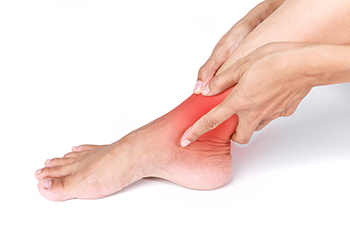
Ankle pain, often caused by injury, instability, or arthritis, can significantly increase the risk of developing osteoarthritis in the knee. When the ankle joint is compromised, it disrupts the natural biomechanics of walking leading to altered gait patterns. This imbalance shifts excessive stress to the knee joint as it compensates for the weakened ankle, accelerating cartilage wear and tear. Over time, the increased joint load contributes to inflammation, pain, and the progressive breakdown of knee cartilage, a hallmark of osteoarthritis. Addressing ankle pain early is essential to prevent this chain reaction. Podiatric treatments such as strengthening exercises, orthotics, or bracing can restore ankle stability and proper alignment. If you have ankle pain, it is suggested that you visit a podiatrist to have an exam and obtain treatment to prevent long-term complications, such as knee arthritis.
Ankle pain can be caused by a number of problems and may be potentially serious. If you have ankle pain, consult with Anas Khoury, DPM from North Eastern Foot & Ankle Specialists. Our doctor will assess your condition and provide you with quality foot and ankle treatment.
Ankle pain is any condition that causes pain in the ankle. Due to the fact that the ankle consists of tendons, muscles, bones, and ligaments, ankle pain can come from a number of different conditions.
Causes
The most common causes of ankle pain include:
- Types of arthritis (rheumatoid, osteoarthritis, and gout)
- Ankle sprains
- Broken ankles
- Achilles tendonitis
- Achilles tendon rupture
- Stress fractures
- Bursitis
- Tarsal tunnel syndrome
- Plantar fasciitis
Symptoms
Symptoms of ankle injury vary based upon the condition. Pain may include general pain and discomfort, swelling, aching, redness, bruising, burning or stabbing sensations, and/or loss of sensation.
Diagnosis
Due to the wide variety of potential causes of ankle pain, podiatrists will utilize a number of different methods to properly diagnose ankle pain. This can include asking for personal and family medical histories and of any recent injuries. Further diagnosis may include sensation tests, a physical examination, and potentially x-rays or other imaging tests.
Treatment
Just as the range of causes varies widely, so do treatments. Some more common treatments are rest, ice packs, keeping pressure off the foot, orthotics and braces, medication for inflammation and pain, and surgery.
If you have any questions please feel free to contact our office located in Passaic, NJ . We offer the newest diagnostic tools and technology to treat your foot and ankle needs.
Foot Orthotics and Plantar Fasciopathy
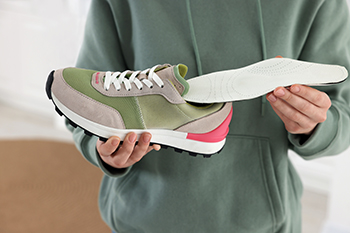
First-step pain is a hallmark symptom of plantar fasciopathy, often causing significant discomfort upon getting out of bed or after sitting for extended periods. Custom foot orthotics can be extremely effective in reducing this pain. By providing individualized support tailored to the unique shape and structure of the foot, orthotics help to distribute weight evenly and alleviate pressure on the affected heel. This can significantly reduce the tension on the plantar fascia, especially during the initial steps after rest. Custom orthotics can also help correct foot misalignment or abnormal gait patterns that may contribute to the condition. Over time, this support helps reduce inflammation and promotes healing by limiting repetitive stress on the fascia. For many people, wearing custom orthotics leads to noticeable improvements in both first-step pain and overall comfort throughout the day. If you have heel pain, it is suggested that you consult a podiatrist who can properly diagnose the cause, and offer custom-made orthotics as a treatment solution.
Custom orthotics are specialized shoe inserts created to support and align the feet according to each person’s unique structure and walking pattern. They are an effective way to relieve foot discomfort caused by conditions such as flat feet, high arches, plantar fasciitis, bunions, and heel pain. When the natural alignment of the foot is off balance, it can lead to pressure points, strain, and pain that affect how a person stands, walks, and moves. Orthotics work by redistributing weight evenly and supporting the arch to reduce stress on the muscles, tendons, and joints of the feet and lower legs.
Foot discomfort can develop for many reasons, including wearing improper footwear, long hours of standing, repetitive motion, or underlying structural problems. Over time, this discomfort can extend beyond the feet, contributing to knee, hip, or lower back pain. Custom orthotics help correct these issues by improving alignment and promoting more efficient movement. They are made using precise measurements and imaging to ensure the best fit for each patient, providing targeted support and cushioning where it is needed most.
Unlike generic insoles, custom orthotics are durable, medically designed, and tailored to your specific needs. Whether you are managing chronic pain, recovering from an injury, or simply seeking better comfort and stability, orthotics can make a noticeable difference in how your feet feel throughout the day.
If you are experiencing persistent foot discomfort or fatigue, it may be time to have your feet evaluated by a podiatrist. Call our office today for more information or to schedule an appointment.
If you have any questions, please feel free to contact our office located in Passaic, NJ .
How Cuboid Syndrome Is Diagnosed
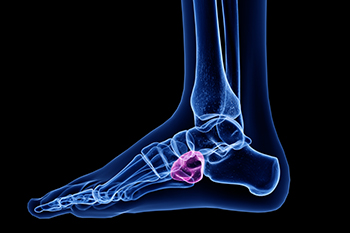
Cuboid syndrome is a condition that affects the foot, specifically the cuboid bone, which is one of the seven tarsal bones located on the outer side of the foot. This syndrome occurs when the cuboid bone becomes slightly misaligned or stiff, often leading to pain in the outer part of the foot. The main causes of cuboid syndrome include sudden movements, foot injuries, overuse, or wearing improper footwear. Activities such as running, jumping, or twisting can strain the cuboid bone and surrounding tissues. Common symptoms include localized pain, swelling, and tenderness on the outer foot, in addition to difficulty walking or bearing weight. To diagnose cuboid syndrome, a podiatrist typically conducts a physical examination and may perform specific manipulation tests. In some cases, imaging tests like X-rays or MRI scans may be used to rule out other conditions and confirm the diagnosis. If you have pain in the outer part of your foot, it is suggested that you consult a podiatrist who can accurately diagnose and treat the problem.
Cuboid syndrome, also known as cuboid subluxation, occurs when the joints and ligaments near the cuboid bone in the foot become torn. If you have cuboid syndrome, consult with Anas Khoury, DPM from North Eastern Foot & Ankle Specialists. Our doctor will assess your condition and provide you with quality foot and ankle treatment.
Cuboid syndrome is a common cause of lateral foot pain, which is pain on the outside of the foot. The condition may happen suddenly due to an ankle sprain, or it may develop slowly overtime from repetitive tension through the bone and surrounding structures.
Causes
The most common causes of cuboid syndrome include:
- Injury – The most common cause of this ailment is an ankle sprain.
- Repetitive Strain – Tension placed through the peroneus longus muscle from repetitive activities such as jumping and running may cause excessive traction on the bone causing it to sublux.
- Altered Foot Biomechanics – Most people suffering from cuboid subluxation have flat feet.
Symptoms
A common symptom of cuboid syndrome is pain along the outside of the foot which can be felt in the ankle and toes. This pain may create walking difficulties and may cause those with the condition to walk with a limp.
Diagnosis
Diagnosis of cuboid syndrome is often difficult, and it is often misdiagnosed. X-rays, MRIs and CT scans often fail to properly show the cuboid subluxation. Although there isn’t a specific test used to diagnose cuboid syndrome, your podiatrist will usually check if pain is felt while pressing firmly on the cuboid bone of your foot.
Treatment
Just as the range of causes varies widely, so do treatments. Some more common treatments are ice therapy, rest, exercise, taping, and orthotics.
If you have any questions, please feel free to contact our office located in Passaic, NJ . We offer the newest diagnostic and treatment technologies for all your foot care needs.
What Is a Lisfranc Injury?

A Lisfranc injury refers to damage to bones in the midfoot, specifically the joint complex where the bones of the foot meet. This type of injury often occurs from a traumatic event, such as a car accident, sports injury, or a fall from height, where excessive force is applied to the foot. It can also happen in lower-impact scenarios, like twisting the foot awkwardly while walking or running. Symptoms of a Lisfranc injury include pain, swelling, bruising, and difficulty bearing weight on the affected foot. In severe cases, there may be visible deformity. Treatment depends on the severity of the injury. Minor injuries may be treated with immobilization, while more severe cases may require surgery to realign the bones and stabilize the joint. A podiatrist can accurately diagnose a Lisfranc injury through a physical exam and imaging, and develop a treatment plan to help restore function and alleviate pain. If you suspect a Lisfranc injury, it is suggested that you schedule an appointment with a podiatrist for the right care.
Foot Pain
Foot pain can be extremely painful and debilitating. If you have a foot pain, consult with Anas Khoury, DPM from North Eastern Foot & Ankle Specialists. Our doctor will assess your condition and provide you with quality foot and ankle treatment.
Causes
Foot pain is a very broad condition that could be caused by one or more ailments. The most common include:
- Bunions
- Hammertoes
- Plantar Fasciitis
- Bone Spurs
- Corns
- Tarsal Tunnel Syndrome
- Ingrown Toenails
- Arthritis (such as Gout, Rheumatoid, and Osteoarthritis)
- Flat Feet
- Injury (from stress fractures, broken toe, foot, ankle, Achilles tendon ruptures, and sprains)
- And more
Diagnosis
To figure out the cause of foot pain, podiatrists utilize several different methods. This can range from simple visual inspections and sensation tests to X-rays and MRI scans. Prior medical history, family medical history, and any recent physical traumatic events will all be taken into consideration for a proper diagnosis.
Treatment
Treatment depends upon the cause of the foot pain. Whether it is resting, staying off the foot, or having surgery; podiatrists have a number of treatment options available for foot pain.
If you have any questions, please feel free to contact our office located in Passaic, NJ . We offer the newest diagnostic and treatment technologies for all your foot care needs.

